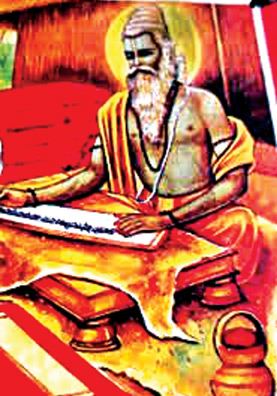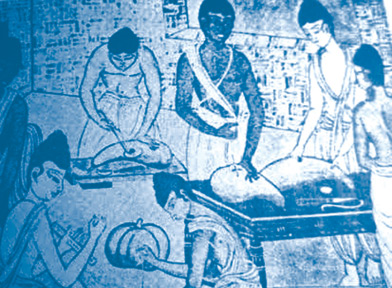Ayurveda, the science and art of wholesome living
by W.T.J.S.Kaviratne Ambalangoda Special Corr.
 The Sanskrit word Ayurveda is comprised of two words of ‘Ayus’ and
‘Veda ’. The Sanskrit word Ayurveda is comprised of two words of ‘Ayus’ and
‘Veda ’.
‘Ayur’ means longevity and ‘Veda’ means the knowledge or science of
life. Ayurveda is not only an ancient curative medical system but an
integrated concept of life dealing on how an individual should maintain
day to day and seasonal routines of life, food, sleep, environment,
therapeutics etc.
Ayurvedic physician Amurthaleka Rajeswari who hails from Batapola in
the Ambalangoda electorate has inherited Ayurvedic systems of medicine
from her father late Prof Harischandra Kaviratne. Prof Harischandra
Kaviratne happened to be an erudite scholar well versed in Sanskrit,
English and several European languages had written numerous books on
Yoga, Indian Philosophy and the first to translate Greek philosophy into
Sinhala.
He had also made several trips to Europe including Denmark and
Holland accompanied by his daughter Rajeswari on the mission of
propagating Ayurveda.
Referring to the origins of Ayurveda, Ayurvedic physician Rajeswari
said almost all ancient treatises on Ayurveda compiled in Sanskrit such
as Charaka Samhita, Susruta Samhaita, Astangra Hrdaya, Madahava Nidana,
Sangadara Samhita and Bhavaparakasa stress on the harmony of body, mind
and spirit. Ayurveda deals with physical health, mental health and
spiritual health, she further said.
Ayurvedic physician Rajeswari happens to be a voracious reader of
books written on Ayurveda in Sanskrit and English and possesses a good
knowledge on the subject. She said that her personal belief is that
Ayurveda is a philosophy, a kind of a Religion and a Way of Living.
Speaking on Ayurvedic Treatments practised in tourist hotels she said
if it was done by genuine Ayurvedic physicians it was of no harm but so
far no action was being taken by the relevant authorities on bogus
institutions involved in nefarious activities on the guise of Ayurveda.
A good knowledge of Sanskrit is indispensable to be an efficient
Ayurvedic physician, she said.
Almost all the ancient treatises compiled in Sanskrit on Ayurveda
such as Charaka Samhita, Susruta Samahita, Astanga Hrdaya, Madahava
Nidana, Sangadara Samhita and Bhavaparakasa stress on the harmony of
body, mind and spirit. It deals on physical health, mental health and
spiritual health.
Ayurveda, unlike other systems of medicine, rather than providing
treatments for symptoms, takes into account the whole patient
holistically in the prevention and the treatment of the disease.
Some of the scholars who had done research on Ayurveda define it as
the ‘Lore of Life’.
The era of the origins of this ancient Indian system of medicine is
uncertain, some scholars claim it is about 3,000 to 5,000 years old and
was in practice even before the origin of Buddhism and Christianity.
Ayurveda is one of the branches of Vedas. Most of the healing lore
and Ayurvedic tenets are given in the sub branch of Atharva-veda.
|

Ayurveda - the 'lore of life' |
But Ayurveda is considered as a stream of knowledge coming down from
generation to generation since eternity parallel to the Vedic
literature.
Divine response
According to both the ‘Susruta Samhita’ considered as the most
ancient compendium ever compiled on Surgery and Charaka Samhita,
describe the origin of Ayurveda as a divine response to the appeal made
by the sages (rishis) on the sufferings of the humanity Charaka Samhita
explains how Bhardwaja, a great ascetic representing other sages went to
the God Indra.
According to Charaka Samhita, Prajapati received Ayurveda as
explained by Brahma and from Brahma it was received by Aswins and from
Aswins it came down to the Lord Indra.
In Susrutha Samhita a quite similar appeal was made to Divodsa
Dhanvantari by a different group of sages on the same issues.
According to Charaka Samhita the living beings were gravely affected
by diversity of diseases and the life span was very short, the diseases
prevented in penance, abstinence, study, celibacy and religious
observances.
To relieve the living out of suffering, the great sages assembled on
one of the auspicious sides of the Himalayas.
Angira, Jamadagni, Vasistha, Kasyapa, Atreya, Sankhya, Vamadeva,
Viswamithra Bharadwaja, and several other sages were among them.
Aupadhenava, Vaitrarana, Susruta, Aurabhra were among the sages who
approached Divodasa Dhanvantari to learn Ayurveda to relieve the
suffering humanity from various afflictions.
Lord Brahma according to Susruta Samhita founded Ayurveda a branch of
Atharva-veda even before creating living beings. Ayurveda was composed
in hundred thousand verses and divided into thousand chapters.
But later he divided Ayurveda into eight branches such as
Surgery(Salya tantra), Ophtholmology, Otorhino-laryngiology (Salakya
tantra), Inner Medicine (Kaya Chikitsa), Demonology (Bhuta Vidya),
Paediatrics (Kaumarabhrtya tantra), Toxicology (Agada tantra),
Rejuvination (Rasayana tantra) and Virilification (Vajikarana tantra).
Narrative of Charaka Samhita reveals that Ayurvedic tradition up to
the God Indra was divine in nature.
It was the great sage Bharadwaja or Atri who brought it to the
terrestrial level. Punarvasu Atreya the great sage held numerous
symposia throughout India and conducted discussions to formulate
concepts of Ayurveda. Atreya’s disciples were comprised of six
illustrious sages of great erudition such as Agnivesa, Bhela, Jatukarna,
Pasrasara, Haritha and Ksarapani. Out of all of them most brilliant sage
was Agnivesa who documented the precepts of Ayurveda discussed by Atreya
and Agnivesa’s compendiumon Ayurveda was known as Agnivesa-tantra (Agnivesa
treatise). Other disciples also compiled their own compendiums but
Agnivesa - tantra became the most popular treatise on Atreya School of
Ayurveda medicine.
The Agnivesa Samhita which was considered as the most popular
compendium of Ayurveda even praised by the divinity was proved to be
insufficient in handling the ever increasing ailments of the humanity.
About 800 years later since the compilation of Agnivesa Samhita, to
meet the day-to-day requirements of the suffering communities of the
era, Agnivesa Samhita was reformed and enlarged reproduced with several
additions as Charaka Samhita by a scholarly Ayurvedic physician known as
Charaka. Some were of the opinion that Charaka was a sage.
Contributions of Charaka Samhita to Ayurveda. The main contributions
of Charaka Samhita to Ayurveda:
|

The whole patient is taken into account holistically |
(i) Advancement of Basic Concepts of Vedic period. Both physiological
and pathological aspects had been interpreted scientifically and
logically.
(ii) Rational attitude by getting rid of blind beliefs and
superstitions prevailed in the era on cause and cure of diseases.
(iii) Organisation of Symposia which facilitated the advancement of
knowledge.
(iv) Psychosomatic approach. According to Charaka Samhita man is
considered as a whole known as Purusa. Both Tridosa and Psyche interact
with each other and Psychosomatic approach plays a key role in Ayurveda.
(v) Individual Constitution: Emphasis is laid on individual
differences on psychic and somatic constitution. Every therapy has to be
applied taking into account the constitution of an individual. (vi)
Expansion: Ayurvedic medicine is expanded in accordance with Etilogy (Hetu),
Signs (Linga) and Therapeytics (Medicine).
(vii) Scientific Method of Diagnosis: According to Charaka Samhita,
the facts about the patient should be gathered using scriptures,
perception and inference. The disease has to be examined in respect of
etilogy, prodormal symptoms, suitability and pathogenesis.
(viii) Importance of Nature: Charaka Samhita emphasised on the
recession by nature (Swabhavoparama) and evacuative therapy (Samsodana).
(ix) Promotion and Prevention: Charaka Samhita deals on the promotion
of life. Code of good conduct which helps to remain healthy and
long-lived.
(x) Scientific study of drugs: It is evident from the Osadhi Sukta of
Rig Veda and Atharva Veda Plants had been studied analytically during
the Vedic period. Charka Samhita had documented the scientific study of
morphology and pharmacological activity of the medicinal plants (Ayurvedic
herbs) during the post-vedic period.
Whether Charaka was an individual or a traditional group and the era
he lived were subjects of controversy and vary from scholars of
Ayurvedic research. Some claim Charaka was a an Ayurvedic physician
lived in the vedic era between 5th century B.C. and 6th century A.D.
Nearly 400 years after Charaka, another Ayurvedic physician called
Dradhabala in the 4th century A.D. during the Gupta period reconstructed
the Charaka Samhita adding another 17 chapters.
According to the Ayurveda the three humours or characteristics (Doshas)
in a living body known as Vata, Pittta and Kapha influence the organism.
Dosha means that which goes out of balance easily. These dhosas are
condensed out of the Five Great Elements. Vata arises from Air and
Ether, Pitta from Fire and Water, and Kapha from Water and Earth. Each
Dosha is composed of two elements. One functions as its active component
while the other acts as the passive component. Vata, Pitta and Kapha are
representative of Air , Fire and Water respectively.
Pitta
Pitta governs all movements in the physical body of every living
being. Pitta governs all transformations of every kind particularly
digestion of food. Kapha governs stability including functions as
lubrication of joints and organs. Bile, phlegm and other bodily
secretions are vehicles for the three Doshas.
All five elements are essential for the survival of living beings. If
the three Doshas are balanced the harmony of these five elements could
maintain the health of an individual and if they are not balanced the
health could be affected.
A healthy person produces just the sufficient amount of three dhosas
to meet the physical needs.
Unhealthy body produces more or less than the amount of three dhosas.
Over production or under production of three dhosas affect the vitality,
adaptability and immunity.
The food comprised of Earth and Water increases the body’s proportion
of Earth and Water resulting the increase of Kapha in the body. The
three dhosas increase and decrease in the body according to the
qualities in the body. The qualities absorb from the food, drink,
environment, thoughts and even the emotions of a person possess the
qualities affecting the doshas in the body.
Dosas
Vata is dry, cold, light, unstable, clear, rough and subtle. Pitta is
slightly oily, hot, intense, light, fluid and mobile. Kapha is oily,
cold, heavy, stable, viscid, smooth and soft.
Diseases due to excess Kapha: Congestion, bronchial nasal discharge,
sluggish digestion, nausea, slow mental response, idleness, desire for
sleep and excess weight.
Kapha body type: Well built and having problems with the weight,
Kapha people are naturally athletic, they are sensitive and emotional
and require understanding. The hair is thick and wavy, skin is smooth
and eyes are large and attractive.
Susruta son of the sage Visvamitra is believed to be the author who
compiled the treatise on ancient Ayurvedic surgery known as Susruta
Samhita which describes the knowledge gathered on surgery from the
teachings of Devodasa Dhanvantari who was the teacher of Susruta.
Quite similar to the narration given at the beginning of Charaka
Samhita, even Susruta Samhita introduced how the ancient sages made an
appeal to Divodasa Dhanvantari to come to rescue the sufferings of the
humanity and to teach them Ayurveda with special emphasis on surgery. (Salyatantra)
The period of Devodasa Dhanvantari and Susruta also vary from 1000 B.C.
to 1500B.C.
|

